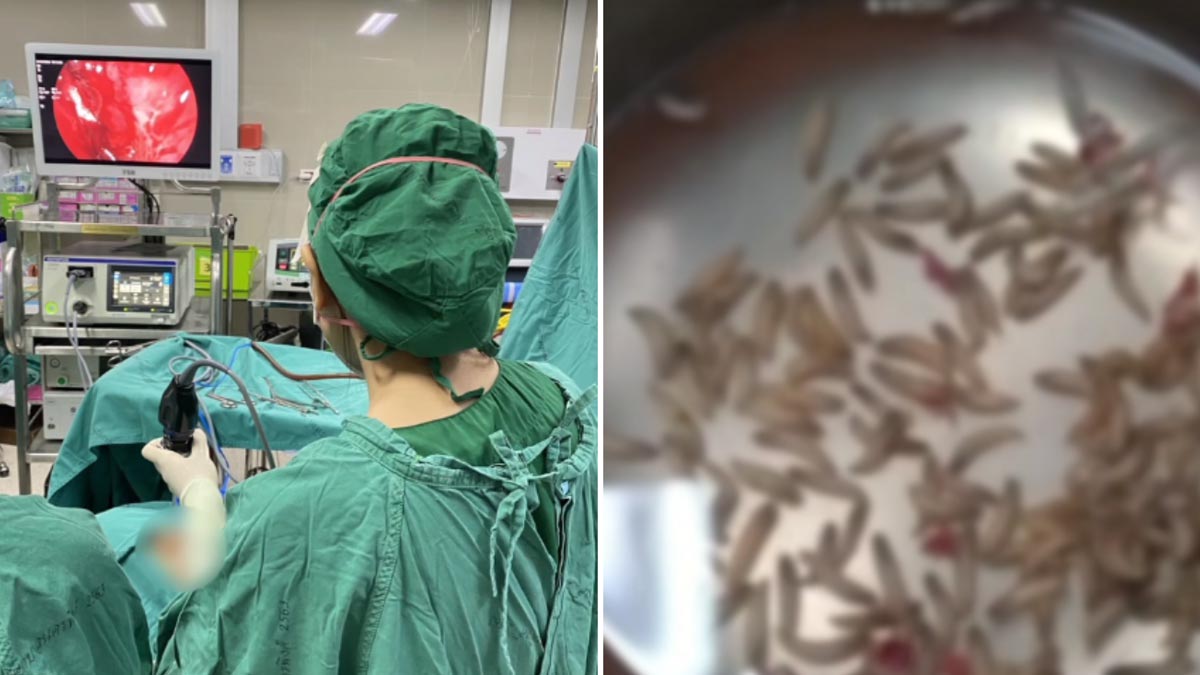
A 59-year-old woman from Chiang Mai, Thailand, endured a week of nasal congestion and facial pain before a nosebleed unveiled a horrifying truth: her nostrils were infested with hundreds of maggots.
Immediately taken to Nakornping Hospital, Dr Pateemon Thanachaikhan reviewed her X-rays and identified foreign objects in her nostrils. Using an endoscope, the medical team found over 100 maggots wriggling inside. Following their removal, the woman's condition significantly improved.
Table of Content:-
Thousand Maggots Found In Thai Woman’s Nose
Had the larvae remained untreated, they could have migrated to nearby organs like the eyes or brain, causing severe complications or even death, said the doctors who treated her. The northern regions of Thailand, particularly Chiang Mai, have a higher incidence of respiratory issues such as allergies and rhinitis, potentially increasing the risk of such infestations.

Nakornping Hospital shared the case on Facebook, explaining, ‘A 59-year-old woman had a stuffy nose and facial pain for a week, suspected to be due to PM 2.5 dust. Endoscopy revealed numerous worms in her nasal cavity. After experiencing a nosebleed and seeing maggots, she sought treatment at Nakornping Hospital.’
Dr. Pateemon Thanachaikhan, an otolaryngologist, examined the X-ray, which showed a white blemish in the left zygomatic sinus. Endoscopy revealed more than 100 worms in both nasal cavities, which were removed with forceps. The patient is now safe.
What Causes Flesh-Eating Maggots?
The idea of flesh-eating maggots thriving in one's ear, nose, or throat (ENT) cavity is horrifying and may seem like a scene from a nightmare. However, such infestations, known as myiasis, can occur under certain conditions.
According to the Centres for Disease Control and Prevention, here’s what causes myiasis:
Poor Hygiene and Sanitation
Lack of cleanliness and sanitation is a significant factor in the development of myiasis. Dirty and unhygienic conditions can attract flies that lay eggs in open wounds or body orifices, leading to maggot infestation.
Also Read: Ayurvedic Home Remedies for Stomach Worms: 7 Natural Solutions for Digestive Health

Open Wounds or Ulcers
Open wounds or ulcers in the nose, mouth, or ears can provide an ideal environment for flies to lay their eggs. These wounds may result from injuries, surgeries, or chronic infections.
Compromised Immune System
Individuals with weakened immune systems are more susceptible to infections, including myiasis. Conditions such as diabetes, HIV/AIDS, and other immunocompromising diseases increase the risk of infestation.
Chronic Sinusitis and Rhinitis
Chronic sinus infections or allergic rhinitis can create an environment conducive to maggot infestation. Persistent inflammation and mucus buildup can attract flies.
Poor Living Conditions
Living in areas with poor sanitation, inadequate waste disposal, and high fly populations increases the risk of myiasis. Rural and underdeveloped regions are particularly vulnerable.
Travel to Endemic Areas
Travelling to regions where myiasis is more common can increase the risk of infestation. Certain tropical and subtropical areas have higher incidences of myiasis due to the prevalence of flies.
Also Read: Ever Heard Of Pinworms: Here Are Some Natural Remedies To Remove Them
While flesh-eating maggot infestations in the ENT cavity are rare, they can occur under specific conditions, particularly in individuals with poor hygiene, compromised immune systems, or chronic ENT conditions. Understanding the causes and symptoms of myiasis can help in early detection and treatment, preventing serious complications. Maintaining good hygiene, protecting open wounds, and seeking prompt medical attention for persistent ENT issues are crucial steps in preventing such infestations.
Also watch this video
How we keep this article up to date:
We work with experts and keep a close eye on the latest in health and wellness. Whenever there is a new research or helpful information, we update our articles with accurate and useful advice.
Current Version
